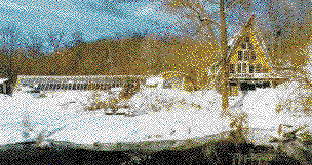

Project Summary
Solar Cold Climate Greenhouse (SCCG) technology can change the economic competitiveness of Wisconsin vegetable, specialty produce and greenhouse growers creating year round crops with little or no heating, lighting or cooling costs. By drastically reducing or eliminating energy and related equipment costs with SCCG technology, 15-25%* of annual production costs can be eliminated from greenhouse operations. For a business happy to see 5% profit margins* this is a revolution. Wisconsin growers could now compete with foreign and sunbelt growers year round in a wide range of crops. Customers will benefit with fresher produce, numbering the days of the 2000 mile plastic tomato. Along with better tasting produce, SCCG's can take a bite out of Wisconsin's eight billion dollar annual energy bill and create a host of year round home grown Wisconsin jobs and products.
REA Farm has successfully demonstrated a 1600 square foot prototype (SCCG 1). SCCG 1 has three years of successful test results(see pages 39-40). It has maintained excellent temperatures and humidities without the use of heating fuels usually costing $1.00 or more per square foot of growing area per year. This year, ripe tomatos were growing in early February even after record -30-40 below temperatures proving that even hot weather crops could be grown in the cold, low light of winter. One unique design feature of this greenhouse utilizes operable insulation shutters to insulate the south sloped glazing at night (to an R-20), automatically opening during the day to reflect sunlight off of snow. The effect amplifies by as much as 140% the often inadequate winter light expanding the range of crops which will grow well in Wisconsin winters. SCCG 1 was designed for the Badgersett Research Farm in Canton Minnesota as a three crop nursery for hybrid seedling hazel and chestnut trees with an annual export of 30,000 trees worth $80,000 (New Farm magazine article Feb.'94 ).
Our goals are to build SCCG 2 for under $10 per square foot with under
10¢ per square foot operating costs. REA has established these costs
as acheviable. 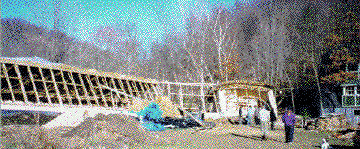 Once
documented they would place REA in a highly competitive position with conventional
four season greenhouses costing between $5-20 per square foot to build.
SCCG 2 will demonstrate four season flower, herb, and vegetable growing
with on site tours for prospective growers and interested media. We will
publish our results in state journals and national magazines giving economic
feasibility's for a representative group of high-end produce, cut flowers,
and herbs. We will use SCCG 2 and the resulting data as an on site marketing
tool to approach growers as design consultants in the planning and construction
of SCCGs.
Once
documented they would place REA in a highly competitive position with conventional
four season greenhouses costing between $5-20 per square foot to build.
SCCG 2 will demonstrate four season flower, herb, and vegetable growing
with on site tours for prospective growers and interested media. We will
publish our results in state journals and national magazines giving economic
feasibility's for a representative group of high-end produce, cut flowers,
and herbs. We will use SCCG 2 and the resulting data as an on site marketing
tool to approach growers as design consultants in the planning and construction
of SCCGs.
Wisconsin growers can compete year round in a wide range of high-end produce, herb and flower markets by reducing energy costs of heating, lighting, and venting. By reducing the energy intensiveness of growing off season, local growers will be at a freshness, reliability and distribution advantage to out-of-state competition.
Wisconsin produce growers are prisoners of the seasons. Produce growers are excited about the potential for selling off season; it brings the best prices, and distributes income throughout the year. Since conditions inside greenhouses are more controllable, the economic security of grower improves as does the reliability of delivering a consistent product to the market. Grower work loads and rural economies could be stabilized as well as creating year round employment opportunities where before there was only seasonal work. Competition among Wisconsin growers for the limited local summer markets will instead be deferred to displacing imported produce year round. This should reduce over production and under pricing during summers as crops ripen throughout the year, expanding the market window and economic pot. Wisconsin's short growing season restricts the types dependability and quality of crops grown in open field plantings. SCCGs could enhance all of these factors. Major food distributors and flower retailers prefer the year round reliability of out-of-state growers exporting hundreds of millions of dollars from Wisconsin annually. Growers, utilizing SCCGs, could open up a billion dollar regional market including Chicago and Minneapolis/St. Paul. Indeed, Wisconsin could become a net exporter of these products to the over ten million people within 100 miles of its boarders. Small scale operations, such as in the hilly driftless region where REA Farm is located, are particularly well suited for SCCG development since large scale highly mechanized agriculture is increasingly impractical in this region. Steep south facing slopes are ideal for solar orientation and SCCG development. This area has suffered some of the states worst soil erosion and water pollution, problems SCCGs could help to reduce. Intensive cultivation of three and even four crops can be harvested on the same land previously producing one crop. Half acre operations could effectively support a family. With land prices and rural economies depressed, this area is poised for new SCCG growers.
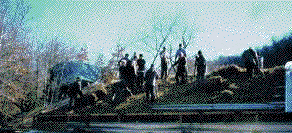
STUDENTS FROM VIROQUA YOUTH INITITIVE HIGH SCHOOL SPEND A DAY INSTALLING THE STRAW BALE ROOF.
Jobs will be created on a year round basis in design, manufacturing construction, cultivation, processing and distribution. New capitol assets will be created , increasing the state's property and income tax base from this new economy of crops. For the small family farm dairies, SCCGs could provide an alternative second income base integrated into the farm infrastructure; excess solar heat from SCCGs can be used in homes, milking parlors, poultry, and pig sheds reducing heating costs and air and water pollution; manure and yard wastes can be used for greenhouse compost. Indeed animal husbandry and greenhouse production are symbiotic as wastes and gases from one are used by the other.
The EPA sights non point source pollution (primarily farming) as the last significant water pollution culprit. Indeed, Congress has passed a new $100 million program to help control farm manure (see page 30). REA has funding to build a prototype methane digester which will be integrated into SCCG 2 for generation of fertilizer, methane, and CO2 from farm wastes. As well, SCCGs can help prevent water pollution by utilizing farm wastes containing any chemicals used, eliminating soil erosion, and reducing ground water pollution. The benefits extend to cleaning the air by reducing the use of petroleum based heating fuels and electrical demand. Inside SCCGs, soil erosion and chemical runoff can be contained and recycled reducing fertilizer costs as well.
The goals of SCCG technology are many fold. Primarily, SCCGs have the potential to open up huge regional produce markets now dominated by sunbelt states and foreign producers, creating jobs and economic stability in rural communities. Secondarily SCCGs will foster a more sustainable, secure food production and distribution system less dependant on fuel prices while offering improved freshness and quality to the consumer. Additionally SCCGs can help improve the environment by reducing the burning of heating and transportation fuels, soil erosion, and water pollution.
The focused short term goals of this proposal are to: 1) Design and Construct a 2000 sq. ft. commercial prototype SCCG at REA Farm. 2) Record all construction costs for economic feasibility analysis. 3) Select and grow a representative sampling of high-end crops through four seasons. 4) Record the interior/exterior daily high/low temperature, humidity and light levels and the harvest totals and sales receipts for each crop through the grant period. 5) Publish detailed construction and production costs, and crop harvest yields in trade journals and general results in interested newspapers and magazines. 6) Attract SCCG clients by the above and by give ongoing monthly tours of SCCG 2 to clients and media. 7) Design and supervise construction of SCCGs for Wisconsin growers.
The broad long term goals of this project are to: 1) Design and build SCCG 3: a production scale kit SCCG for large scale application. 2) Manufacture or license to manufacture this commercial SCCG kit 3) Market SCCG kits to growers to diversify and expand the fresh produce, herb and flower markets in Wisconsin by offering growers the above technology. 4) Improve the competitiveness of Wisconsin growers by reducing energy costs of growing off season. 5) Create new capitol investment in farm infra-structure in greenhouses, and reduce the use of imported heating fuels. 6) Create year round jobs in farming, distribution, and construction. 7) Develop new agricultural markets in high-end year round crops. 8) Promote the efficient use of farmland by harvesting three and four crops on acreage previously producing one. 9) Develop more sustainable farming practices by reducing soil erosion and water pollution and utilizing organic farm wastes. 10) Stabilize and secure farm income year round by providing protection from climatic vagaries, and grower dependence on the summer growing season. 11) Symbiotically integrate animal husbandry, and aqua culture into greenhouses to increase production and reduce organic wastes.
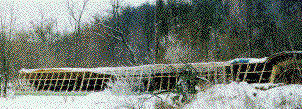
Solar Cold Climate Greenhouses can contribute to Wisconsin's fastest growing agricultural sectors: produce and flowers. According to the 1991 Wisconsin Blue Book (see page 41) cash receipts from farm marketing of Miscellaneous vegetables grew 423.6% from $25 million in 1980, to over $107 million in 1991(the last year these compiled statistic were available).. Greenhouse and Nursery receipts grew 284.3 % from $37 million to over $142 million in the same period. If given an opportunity to become a year round business Wisconsin produce and flower production could quadruple again in the next ten years.
SCCG 2 will serve to refine construction techniques, materials and systems for the development of SCCG 3 which will be a manufacturable kit greenhouse.. SCCG 2 will also demonstrate economic feasibility of this technology and serve as a marketing tool for potential clients and investors. We intend to give growers and their lending institutions solid numbers on production costs and sales for a representative group of produce, herbs, and flowers. This information will establish payback on investment and profitability, information with which growers can use to seek capitol for greenhouse construction. With SCCG 2 , we will optimize the use of all its systems to more narrowly tailor light, temperatures and humidities for each crop. With SCCG's amplified winter light levels we suspect production per square foot will increase as compared with traditional structures. Beyond data we will have an attractive marketing and research tool for ongoing demonstration where growers and the media can see, smell, feel, and taste the results.
In our initial market analysis, conducted for us by the Small Business
Institute Program, (see pages) we have found a substantial SCCG market
exists in the $8 to $12 per sq. ft. range. Low end greenhouses cost between
$3 to $5 per sq. ft. including mechanical systems, and require another
$1 per sq. ft. or more to annually heat and vent. Cost estimates on SCCG
2 are below $5 per sq. ft. when using on site materials, and under $10
per sq. ft. when using conventional materials. 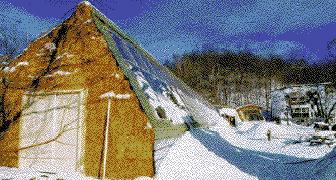
SCCG 1, Built for Badgersett Research Farm, has proven that auxiliary heating for year round operation is unnecessary. It has also proven light levels can be increased 140% ambient by utilizing operable insulation shutters to reflect light off snow. This also increases the radiant heat input. When snow melts with spring warming, inside temperatures decreased. The shutters also performed well to shade the greenhouse in the summer, preventing overheating, reducing ventilation requirements thus eliminating another 3-5% of total operating costs. SCCG 1 performed best in below zero weather; January '94(the fourth coldest on record in southeastern Minnesota) inside daytime temperatures were in the 80's. The hardy hazel and chestnut seedlings have grown exceedingly well without utilizing all of the features of SCCG 1: the shutters were never lowered to insulate the glazing because night time temperatures never fell below 39 degrees, and that occurred when it was 35 below zero outside; fans, which blow excess heat for thermal storage in the earth beneath the greenhouse, have not been fully utilized. Both systems would stabilize the interior temperatures to diurnal swings of ten to twenty degrees producing year round inside conditions ranging from the low 50s to the mid 80s
The second prototype SCCG will prove the economic feasibility of growing a wide range of less hardy lower value crops year round in Wisconsin. SCCG 1 was designed to insure the success of each three month crop of hazel and chestnut seedlings worth more than the greenhouse. SCCG 2 will be tailored for less valuable crops, with more stringent growing temperatures, humidities, and light levels such as red bell peppers, basil and Amaryllis. The operable insulation shutters will be utilized daily to demonstrate their control over incident radiation gain and thermal loss. The soil bed thermal storage system will be fully utilized to balance daily temperatures and humidities while aerating soils and providing heat to plant root systems.
 Constructing
the Black Locust Frame
Constructing
the Black Locust Frame
For More information Contact Roald Gunderson